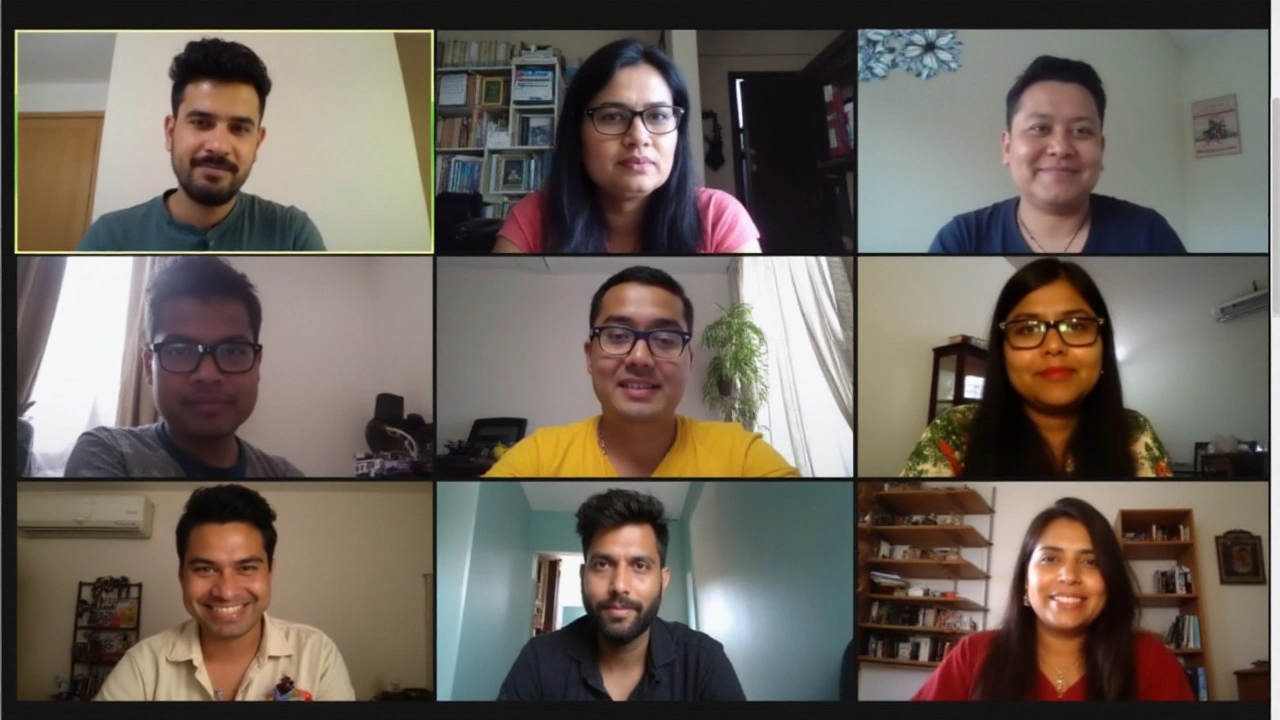The idea of learning programming from home might seem daunting at first, but it's more accessible now than ever before. Gone are the days when you had to enroll in expensive institution-based courses to get started with coding. These days, the internet offers a plethora of resources that cater to every learning style and schedule.
Whether you're looking at YouTube tutorials or signing up for a structured online class, there is no shortage of ways to dive into the programming world from the comfort of your living room. What's crucial is to start with a clear strategy, understand fundamental concepts, and enjoy the journey of turning lines of code into functioning software. The independence of at-home learning lets you shape your path in the tech field, whether it's web development, data science, or any other specialty that catches your interest.
- Getting Started with the Basics
- Choosing the Right Resources
- Creating a Learning Schedule
- Building Real-World Projects
Getting Started with the Basics
Diving into the world of programming can be both exciting and overwhelming. For beginners who want to learn programming at home, the initial step is understanding fundamental concepts such as algorithms, syntax, and logic. These basics form the backbone of any programming language, whether you’re looking at C++, Python, or JavaScript. It's crucial to start with a clear understanding of these core elements since they allow you to grasp more complex topics with ease as you advance.
One of the best ways to get a handle on these basics is through hands-on practice. Theoretical knowledge is important, but programming is a skill best learned by doing. Beginners should invest time in coding small programs, experimenting with different solutions, and even making mistakes. This process of trial and error not only reinforces learning but also boosts problem-solving skills. There's a great amount of satisfaction in troubleshooting your code and finally watching it run as intended.
For those starting their coding journey, there’s a wealth of introductory courses available online. Platforms like Codecademy, Coursera, and Khan Academy offer beginner-friendly modules that break down complex subjects into bite-sized lessons. Many of these resources are free or at least affordable, making them excellent options for anyone hesitant about the initial investment. These platforms give learners the chance to experiment with online programming courses without the pressure of traditional classrooms.
As a reputable source once noted,
"Learning to write programs stretches your mind, and helps you think better, creates a way of thinking about things that I think is helpful in all domains." — Bill Gates. This mindset is imperative for anyone learning to program as it encourages a deeper engagement with the subject. Embracing this philosophy allows learners to develop not just technical skills, but a robust analytical approach to any problem.
Another key aspect of starting with the basics is joining online communities. Sites like Stack Overflow, Reddit, and GitHub are treasure troves of information and support. Often, the query you’ve struggled with has already been encountered by someone else, and these forums can provide quick answers and diverse viewpoints. Coding from home doesn’t mean you have to be isolated; engaging with these communities can make the learning process smoother and more social.
For an aspiring coder, clarity on the home coding journey can be gleamed from websites offering free exercises and challenges that bolster basic programming skills. Exploring websites such as HackerRank or LeetCode can assist in transitioning from beginner to intermediate, offering real-world problems to solve. By persistently practicing and taking small steps each day, you’ll soon notice the inklings of expert confidence. Equipped with a platter full of ideas and resources, taking the first step towards coding mastery begins with the right mindset and a touch of curiosity.

Choosing the Right Resources
Learning programming at home requires more than just dedication; it demands the right toolkit of resources. The digital age offers an array of options, making it essential for aspiring coders to pick resources wisely to enhance their learning journey. At the start, it's crucial to identify your learning style. Are you a visual learner who benefits from video lectures, or do you prefer reading through structured text tutorials? Websites like Coursera, Udemy, and edX offer online programming courses tailored for diverse learning styles, each with interactive modules that can help maintain engagement. These platforms provide lectures from industry experts, making them a reliable starting point.
An often overlooked resource is the thriving community of self-taught programmers who share their knowledge freely. On platforms like GitHub, you can not only access open-source projects to study and contribute to, but also engage with a community that supports newcomers. Participating in forums like Stack Overflow or Reddit's coding subreddits enables you to ask questions, share knowledge, and troubleshoot coding problems with peers and experienced programmers. As one enthusiastic developer put it, "Don't underestimate the power of community when learning to code at home; collaboration is key to solving complex problems."
Online programming courses are incredibly diverse—they vary in subjects, difficulty levels, and costs. Websites like Codecademy make interactive learning fun while covering languages like Python, JavaScript, and more. An advantage of using such resources is the gamified learning approach, where you earn points or badges for completing exercises, which keeps motivation high. For more structured learning, you might consider a subscription service like Pluralsight that allows for tracking progress over time and offers assessments to test comprehension.
For those more accustomed to learning from books, numerous programming texts are available, ranging from beginner to advanced topics. Books like "Automate the Boring Stuff with Python" by Al Sweigart offer hands-on exercises that align well with online tutorials. Having a physical or digital book that guides you can complement your online learning, allowing you to learn at your own pace without relying solely on internet connectivity. This dual approach ensures that you understand theory while also applying it practically.
To illustrate the variety in available resources, consider the following table of popular platforms and their features:
| Platform | Languages Offered | Cost |
|---|---|---|
| Codecademy | Python, JavaScript, HTML/CSS | Free/Pro Version |
| Udemy | Various, including SQL, Java | Per Course Fee |
| edX | Computer Science, Data Analysis | Free/Paid for Certification |
Each tool has its own strengths and weaknesses, so investing some time to explore different options can significantly benefit your personal home coding journey. The key is to remain adaptable and open-minded, as what works for one person may not work for another. Continuously experiment with different platforms and formats until you find the right fit for your goals and learning pace.

Creating a Learning Schedule
Creating a learning schedule is a crucial step when you decide to learn programming at home. Without a structured approach, it’s easy to get lost in the vast resources available. A schedule not only helps maintain discipline but also ensures consistency in your learning journey. Start by assessing your current commitments and identifying time slots that can be dedicated to your studies without causing burnout. Even an hour per day, if used effectively, can lead to significant progress over time. Consistent learning sessions reinforce your understanding and provide an opportunity to regularly engage with coding practices.
One effective technique is to use time-blocking methods, which involves dedicating specific hours of your day solely to learning. This could be during quiet early mornings or calm late evenings, whichever suits your routine best. Within these time blocks, break your session into diverse activities to keep the process engaging. For instance, you might spend the first 20 minutes reviewing past lessons, the next 30 minutes engaging with new concepts, and the final 10 minutes practicing what you’ve learned. Over time, these focused sessions build a rhythm that enhances memory retention and skill acquisition.
Avoid cramming vast amounts of information into short periods, as this can lead to cognitive overload and frustration. Instead, strive for gradual, incremental learning. Mix your learning with hands-on practice, which helps to reinforce theoretical concepts by implementing them in real-world scenarios. For beginners, platforms like Codecademy or freeCodeCamp offer structured lessons with practical exercises that can easily fit into your schedule. As you progress, adding in small projects can be very rewarding to see your growth and understanding materialize.
Every few weeks, evaluate your schedule’s effectiveness and make necessary adjustments. Learning preferences might evolve, so remain flexible with your routine. It might be beneficial to track your progress with a dedicated journal or digital tool, noting down areas of struggle and triumphs. “The only way to learn a new programming language is by writing programs in it,” said Dennis Ritchie, co-creator of C Programming. This quote resonates deeply when carving out time specifically dedicated to practical application. Success in learning programming hinges on consistency, so a flexible yet committed schedule is paramount.
If you find your energy levels fluctuating, remember that learning is a marathon, not a sprint. Pace yourself with built-in breaks during your sessions. These intermissions are crucial for allowing your brain to process new information. A well-balanced approach is knowing when to push through difficult topics and when to take a step back. Such a balance boosts productivity and subsequently, programming proficiency. Engaging with coding communities or forums during breaks can provide a fresh perspective and motivate you to persevere.
Here’s a sample table that compares various programming languages and their typical learning durations for beginners:
| Language | Difficulty Level | Estimated Learning Duration (months) |
|---|---|---|
| Python | Easy | 2-3 |
| JavaScript | Moderate | 3-4 |
| Java | Moderate | 4-6 |
| C++ | Hard | 6-12 |
Lastly, remember that your learning schedule should be as unique as you are. Tailor it to fit both your lifestyle and learning pace. With technology at its peak, personalized learning is more accessible than ever. So embark on this exciting journey to learn programming right from your home, with a schedule that respects your individual pace and preferences.

Building Real-World Projects
Embarking on the path of learning programming at home is an inspiring journey, but nothing truly cements your coding skills like building real-world projects. Projects are where theory meets practice, making them essential for both mastering concepts and developing practical problem-solving abilities. As you construct these projects, imagine them as the bridge between your learning phase and your entry into the professional tech world. Tackling a project is more than just writing code—it's about planning, designing, implementing, and sometimes failing and starting over. This experience mirrors real industry challenges, providing a safe space to make and learn from mistakes.
A well-rounded project can range from a simple calculator or a to-do list app to more complex web applications. At the start, it’s best to begin with manageable projects that are just challenging enough to push your limits without overwhelming you. Each project should aim to expand your understanding of different programming concepts and technologies. As your skills improve, you'll notice that even the most technical documentation starts making sense. It’s important to build a portfolio, showcasing your projects online for potential employers or collaborators to see. An impressive portfolio reflects not only your aptitude but also your dedication and drive.
Getting Started on Projects
Starting your first project can feel like a daunting task, but breaking it down into clear steps can simplify the process. Initially, brainstorm some ideas that spark your interest or solve a personal problem you’ve encountered—passion projects sustain motivation. Research existing solutions to gain insights and identify what unique spin you can bring. With a clear project scope, sketch a roadmap and list the technologies you’ll employ. A project can often be broken into smaller, manageable tasks that cumulatively achieve your desired outcome. Before diving into coding, draw wireframes or mockups to envision the final product, hence avoiding copious design changes during development.
"Projects are the best way to learn anything. Being stuck and researching to find solutions accelerates learning." — Kent Beck, Creator of Extreme Programming
Adopting a trial-and-error methodology is crucial; encountering bugs or design flaws isn’t failure, rather it’s an opportunity to grow. Initially, encounter these hiccups by coding with peer-reviewed languages like Python for beginners or JavaScript for web projects. Connect with communities online where you can receive feedback and guidance—open-source environments are especially beneficial. Tools like GitHub not only serve as repositories for your code but also teach version control proficiency, a core skill for coders. Remember, each project you create not only adds to your knowledge but also brings a sense of achievement, fueling your passion to learn and create even more.
Showcasing and Iterating
With projects complete under your belt, it’s time to showcase your work. Use platforms such as GitHub, personal websites, or portfolio-specific sites to display your creations to the wider public. Sharing your journey publicly invites collaboration, feedback, and sometimes job offers. Adopt a habit of revisiting past projects and iterating upon them with your newfound skills. Iterate not just to fix bugs but to optimize and enhance functionality or user experience. Engaging with potential users or community members for reviews may present insightful suggestions that refine your skills further. Lastly, always document your journey--not only is it valuable to potential employers, but it also helps future-you recollect thought processes and decisions made.
Within time, building these projects would lead you to become proficient in coding as if you were attending rigorous coding classes. Each line of code is a sentence in your programming narrative, led by both challenges conquered and innovation achieved. Let every project be a stepping stone towards becoming an adept programmer, mastering your craft from the comfort of your home.


